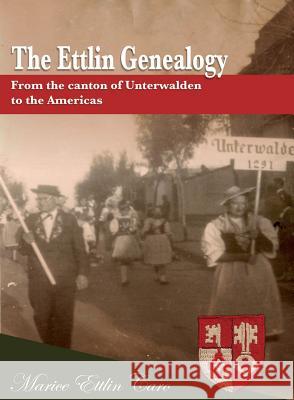The Ettlin Genealogy: From the canton of Unterwalden to the Americas » książka
The Ettlin Genealogy: From the canton of Unterwalden to the Americas
ISBN-13: 9780692573327 / Angielski / Miękka / 2015 / 156 str.
The European emigration of the nineteenth century had a profound effect not only in Europe but also in countries where the colonists settled. Europe was able to stabilize its economy despite suffering two world wars in the twentieth century. In the Americas the immigrants left their footprints. The constitutions of some countries such as Uruguay, was completely rewritten in resemblance to the Swiss. There is always a noble cause that explains the need to migrate, such as hunger, political or religious persecution. The New World offered a new life full of opportunities and progress for the settler and his family. Leaving the native land often meant learning a new language, new customs, and an effort to assimilate into a different society. The price of prosperity was leaving behind loved ones, not knowing if they will ever see them again. The Ettlin of Unterwalden were part of the emigration to the Americas. Several families and individuals traveled to the United States, Brazil, Argentina, and Uruguay. They had the same last name, but also the same place of origin, the canton of Unterwalden which was part of the first Swiss Confederation. We find in this work the ancestors and descendants of the migrants: Peter Paul Ettlin (1851-1925), brother Johann Melchior Ettlin (1843), and his sister Anna Maria Ettlin (1838) with her three children, Maria Ettlin (1870-1962), Engelbert Ettlin (1871-1940) and Josef Alois Ettlin (1878-1917); The brothers Henricka Ettlin Theresa (1901-1955), Blasius Ettlin (1903-1985), and Alois Ettlin (1894-1947); Walter Frank Ettlin (1869-1914); and Walter Joseph Ettlin (1896-1984). The family trees of these immigrants, except one, are attached either biologically or by marriage bond. Because not all these migrants left their experiences in writing, we had to study the history of Unterwalden and those Ettlin which played an important role throughout the long history of Switzerland. Reading the characteristics that made these special people, we find many similarities. There were many Ettlins painters, sculptors, mathematicians, politicians, monks, and teachers. Many of them were also part of the ruling elite families of Obwalden. Despite extensive research by the author, there is a question that has never been answered. Why did Peter Paul Ettlin return to Switzerland leaving seventeen children between Argentina and Uruguay, after having living in South America for forty years?
The European emigration of the nineteenth century had a profound effect not only in Europe but also in countries where the colonists settled. Europe was able to stabilize its economy despite suffering two world wars in the twentieth century. In the Americas the immigrants left their footprints. The constitutions of some countries such as Uruguay, was completely rewritten in resemblance to the Swiss. There is always a noble cause that explains the need to migrate, such as hunger, political or religious persecution. The New World offered a new life full of opportunities and progress for the settler and his family. Leaving the native land often meant learning a new language, new customs, and an effort to assimilate into a different society. The price of prosperity was leaving behind loved ones, not knowing if they will ever see them again. The Ettlin of Unterwalden were part of the emigration to the Americas. Several families and individuals traveled to the United States, Brazil, Argentina, and Uruguay. They had the same last name, but also the same place of origin, the canton of Unterwalden which was part of the first Swiss Confederation. We find in this work the ancestors and descendants of the migrants: Peter Paul Ettlin (1851-1925), brother Johann Melchior Ettlin (1843), and his sister Anna Maria Ettlin (1838) with her three children, Maria Ettlin (1870-1962), Engelbert Ettlin (1871-1940) and Josef Alois Ettlin (1878-1917); The brothers Henricka Ettlin Theresa (1901-1955), Blasius Ettlin (1903-1985), and Alois Ettlin (1894-1947); Walter Frank Ettlin (1869-1914); and Walter Joseph Ettlin (1896-1984). The family trees of these immigrants, except one, are attached either biologically or by marriage bond. Because not all these migrants left their experiences in writing, we had to study the history of Unterwalden and those Ettlin which played an important role throughout the long history of Switzerland. Reading the characteristics that made these special people, we find many similarities. There were many Ettlins painters, sculptors, mathematicians, politicians, monks, and teachers. Many of them were also part of the ruling elite families of Obwalden. Despite extensive research by the author, there is a question that has never been answered. Why did Peter Paul Ettlin return to Switzerland leaving seventeen children between Argentina and Uruguay, after having living in South America for forty years?











